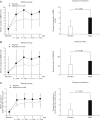A Randomized Double-blind Placebo-controlled Trial on the Effect of Magnesium Oxide in Patients With Chronic Constipation
- PMID: 31587548
- PMCID: PMC6786451
- DOI: 10.5056/jnm18194
A Randomized Double-blind Placebo-controlled Trial on the Effect of Magnesium Oxide in Patients With Chronic Constipation
Abstract
Background/aims: Magnesium oxide (MgO) has been frequently used as a treatment for chronic constipation (CC) since the 1980s in Japan. The aim of this study is to evaluate its therapeutic effects of MgO in Japanese CC patients.
Methods: We conducted a randomized, double-blind placebo-controlled study. Thirty-four female patients with mild to moderate constipation were randomly assigned to either placebo (n = 17) or MgO group (n = 17) 0.5 g × 3/day for 28 days. Primary endpoint was overall improvement over the 4-week study period. Secondary endpoints were changes from baseline in spontaneous bowel movement (SBM), response rates of complete spontaneous bowel movement (CSBM), stool form, colonic transit time (CTT), abdominal symptom, and quality of life.
Results: One patient failed to complete the medication regimen and was omitted from analysis: data from 16 placebo and 17 MgO patients were analyzed. The primary endpoint was met by 25.0% of placebo vs 70.6% of MgO group (P = 0.015). MgO significantly improved SBM changes compared to placebo ( P = 0.002). However, MgO did not significantly improved response rates of CSBM compared to placebo (P = 0.76). In addition, MgO significantly improved Bristol stool form scale changes (P < 0.001) and significantly improved CTT compared to the placebo group (P < 0.001). MgO significantly improved the Japanese version of the patient assessment of constipation quality of life (P = 0.003).
Conclusion: Our placebo-controlled study demonstrated that MgO was effective treatment for improving defecation status and shortened CTT in Japanese CC patients with mild to moderate symptoms.
Keywords: Constipation; Defecation; Double-blind method; Japan; Magnesium oxide.
Conflict of interest statement
Figures







References
LinkOut - more resources
Full Text Sources
Miscellaneous

